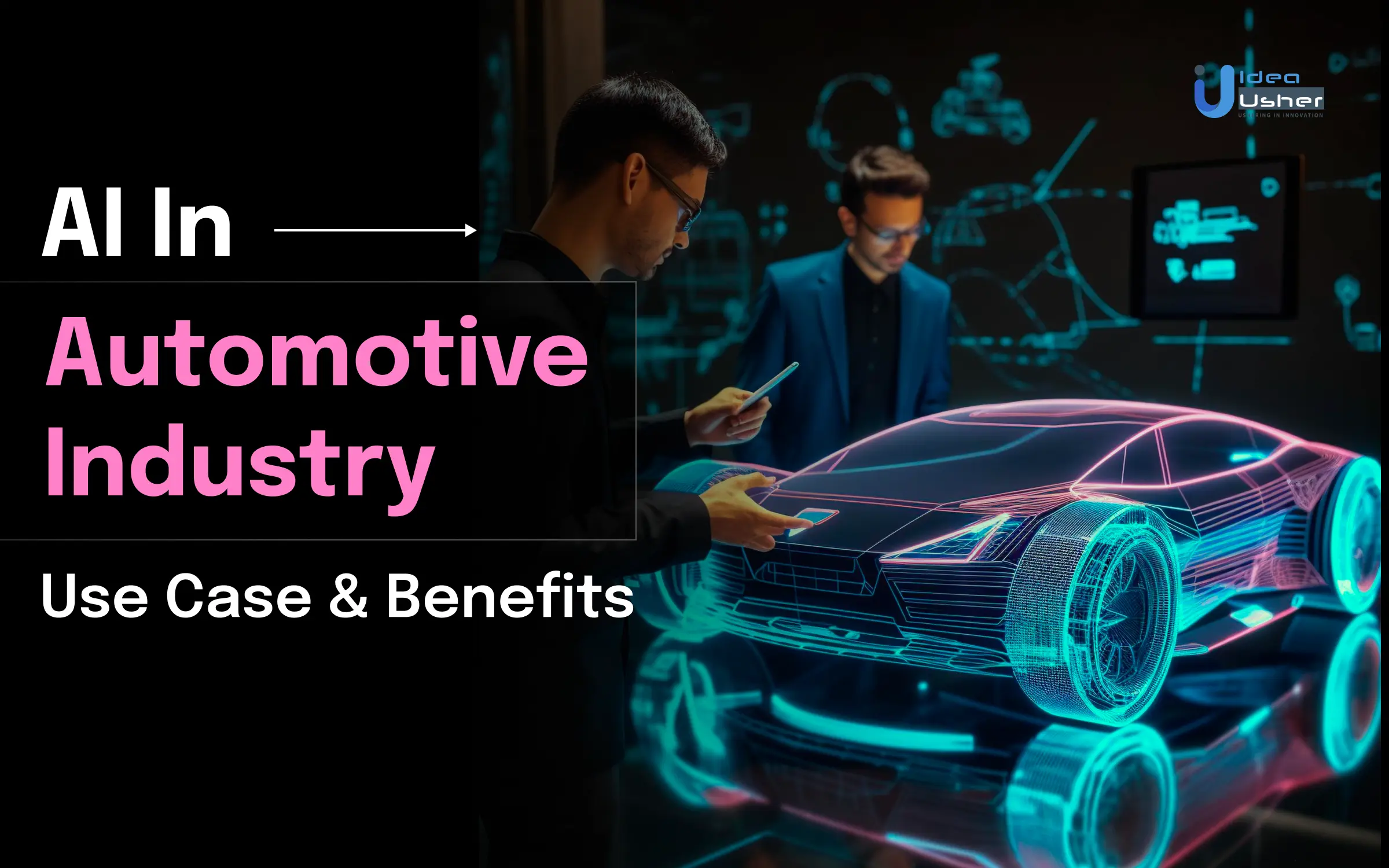Artificial Intelligence (AI) is no longer a concept of the future. It’s here, transforming industries, and the automotive sector is no exception. From enhancing supply chain reliability to powering autonomous vehicles, AI is driving a paradigm shift in how we perceive mobility. It’s not just about getting from point A to B anymore; it’s about the journey, the experience, and the possibilities that AI opens up. This blog will explore the use cases and benefits of AI in the automotive industry, exploring how it revolutionizes manufacturing processes, improves in-vehicle experiences, enables connected vehicles, and reshapes aftermarket services. We’ll also look at the role of AI in autonomous driving technology, backed by advancements in chipsets, edge technology, 5G, IoT, and cloud computing. Despite its transformative impact, the pace of AI implementation in automotive still lags behind other sectors. Yet, with a projected market worth of USD 45.1 billion by 2024, the future of AI in automotive looks promising. Continue reading further as we navigate through this exciting journey of AI-driven transformation in the automotive industry.
The Evolution Of AI In The Automotive Industry
Artificial Intelligence (AI) has been steering the automotive industry towards a new era. From supply chain to autonomous driving, AI’s impact is transformative.
AI has revolutionized supply chain and manufacturing, enhancing reliability and maintainability. Big data and analytics play an instrumental role within the supply chain. The automotive industry has led many initiatives to increase the adoption of such supply chain architectures within their vehicle ecosystems.
AI is also improving in-vehicle experiences and enabling connected vehicles. It’s at the heart of autonomous driving technology. Advancements in chipsets, edge technology, 5G, IoT, and cloud are acting as catalysts.
Moreover, AI is transforming post-purchase services such as predictive maintenance and insurance. Manufacturing robots are collaboratively working alongside human workers, acquiring automotive production skills such as design, part manufacturing, and assembly through AI-driven learning. AI also aids in the development of vehicles using exoskeletons, and it’s envisioned that AI-powered robots could eventually operate entire manufacturing plants. In transportation, AI is driving a revolution. Currently, AI plays a crucial role in driver assistance technology, enjoying widespread use in modern vehicles. Tesla, for instance, offers level 2 autonomous vehicles and has plans to introduce level 4/5 autonomous cars in the future.
The global AI market for automotive is projected to reach USD 45.1 billion by 2024, growing at a CAGR of 17.7% from 2019–2024. Despite this growth, the pace of AI implementation in automotive lags behind sectors like Financial Services and Healthcare.
Role Of Artificial Intelligence In The Automotive Value Chain
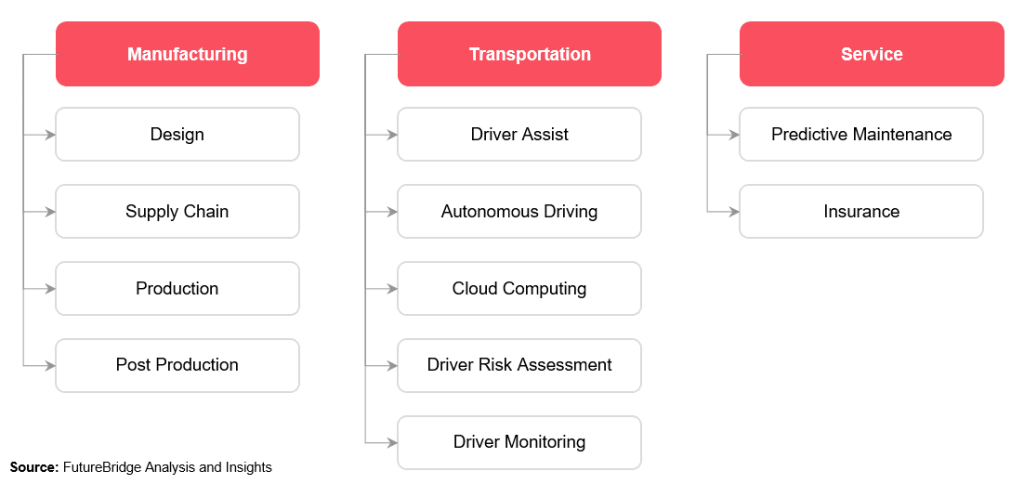
AI is a transformative force in the automotive value chain, reshaping the industry across multiple domains.
1. Design And Manufacturing
AI-driven design processes are revolutionizing automotive manufacturing. Exoskeletons supported by AI algorithms aid human workers, enhancing their efficiency and safety. Furthermore, AI-powered robots are poised to take center stage in factory operations, optimizing production lines and ensuring precision.
2. Supply Chain Optimization
AI’s data-driven insights are streamlining supply chain management, resulting in cost reductions and operational enhancements. Predictive analytics enable just-in-time inventory management, reducing waste and improving resource allocation.
3. Autonomous Driving
AI forms the bedrock of autonomous driving systems, enabling vehicles to make real-time decisions by recognizing and responding to their surroundings. From object detection to route planning, AI empowers self-driving vehicles to navigate safely and efficiently.
4. Connected Vehicles
AI elevates the in-vehicle experience by enabling seamless connectivity. From intelligent infotainment systems to over-the-air updates, AI enhances vehicle capabilities, making them smarter and more responsive to driver and passenger needs.
5. Shared Mobility Services
AI-driven algorithms optimize shared mobility pricing models by accurately predicting and matching supply with demand. Moreover, AI enhances maintenance scheduling and fleet management, ensuring the reliability of shared vehicles.
6. Aftermarket Services
In the aftermarket segment, AI is a game-changer, offering predictive maintenance solutions that anticipate vehicle issues before they occur. AI-driven insurance models tailor coverage to individual driving behavior, enhancing the overall customer experience.
AI’s integration across these domains presents opportunities for cost reduction, operational efficiency, and the creation of new revenue streams. While the automotive industry has made significant strides, there’s ample room for further AI integration. Continued investment and innovation promise to propel AI’s pivotal role in the automotive value chain to new heights.
AI In Automotive Market Statistics
As per Accenture’s findings in 2021, among top executives of the world’s 2,000 largest corporations based on market capitalization, those who included discussions about AI in their earnings calls experienced a 40% higher likelihood of witnessing a rise in their companies’ stock prices. This marked a notable increase from the 23% reported in 2018. However, recent research from Accenture indicates that merely 12% of these companies have progressed sufficiently in their AI capabilities to achieve ‘superior growth’ and undergo significant business transformation. On average, this group of “AI achievers” attributes 30% of their total revenue to AI initiatives.
AI maturity is the measurement of the degree to which “organizations have mastered AI-related capabilities in the right combination to achieve high performance for customers, shareholders, and employees. AI maturity depends on how organizations master a set of key capabilities in the right combination. This is not limited to data and AI but also how AI is used in organizational strategy, talent, and culture.
– Vala Afshar, the Chief Digital Evangelist for Salesforce
There exist four distinct categories of companies concerning their AI maturity:
- AI Achievers: These companies have attained a high level of AI maturity, enabling them to experience ‘superior growth’ and undergo significant business transformation.
- AI Builders: These companies possess solid foundational AI capabilities and display moderate differentiation capabilities.
- AI Innovators: These companies excel in differentiation capabilities while maintaining average foundational AI capabilities.
- AI Experimenters: The majority of surveyed companies, comprising 63%, fall into this category. They demonstrate average capabilities in both foundational and differentiation aspects of AI.
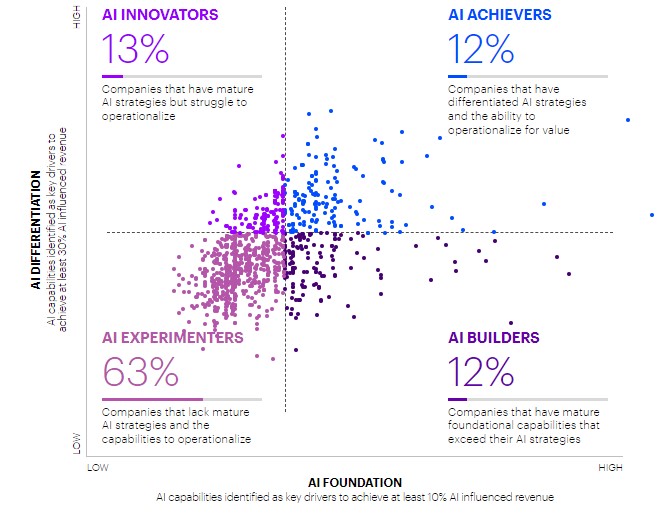
Collectively, the groups of Achievers, Builders, and Innovators make up only 37% of the organizations surveyed. Specifically, Achievers account for 12%, Builders for 12%, and Innovators for 13% of the surveyed organizations.
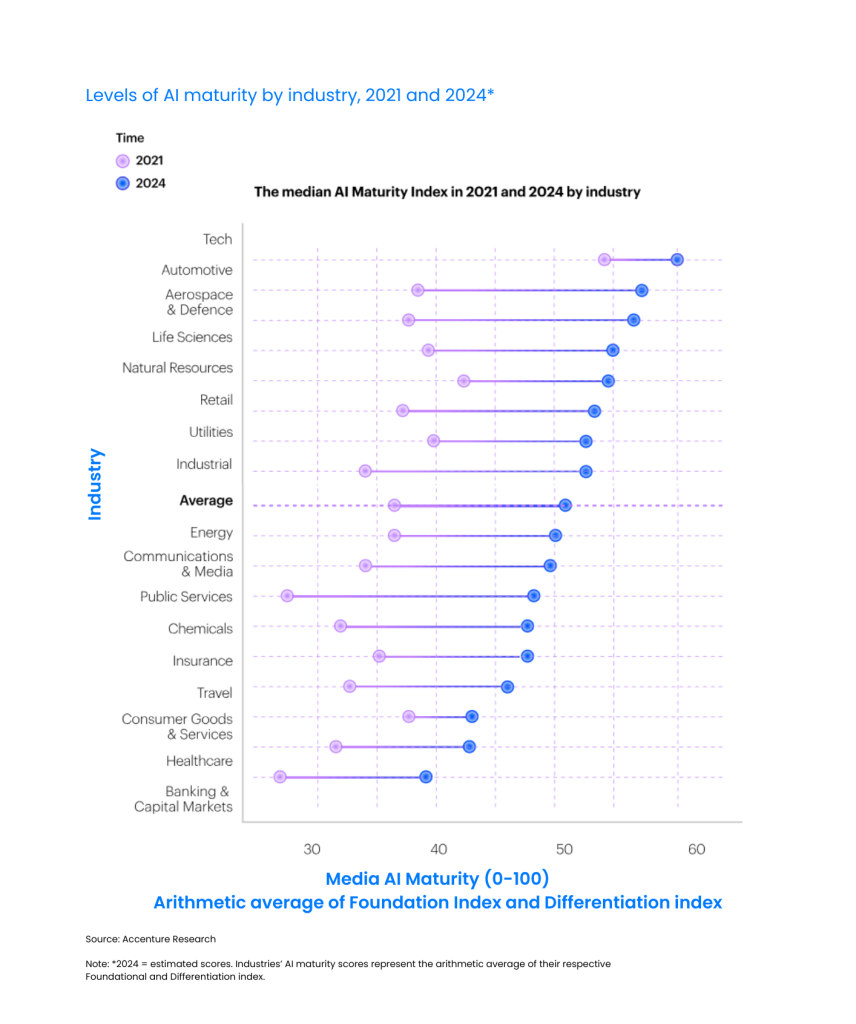
Investment in AI has gone up as more organizations have started using it. For example, five years ago, 40% of those using AI said that more than 5% of their digital budgets were spent on AI. But now, more than half of them say they’re investing at that level. In the future, 63% of respondents expect their organizations to put even more money into AI in the next three years.
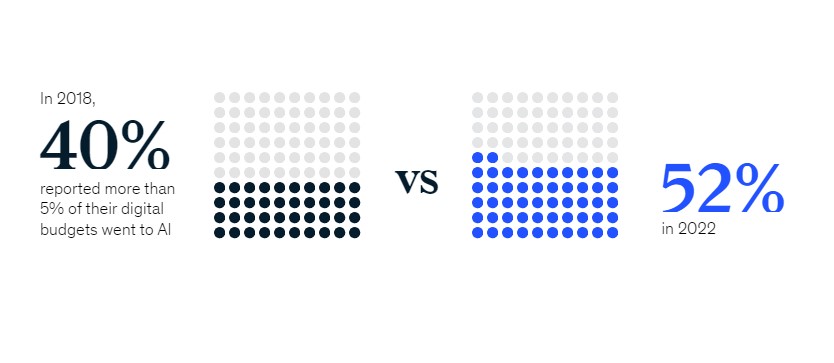
Turning our focus to the automotive sector, the worldwide Artificial Intelligence (AI) market dedicated to the automotive and transportation industry is poised to achieve a value of USD 45.1 billion by 2024, marking a notable Compound Annual Growth Rate (CAGR) of 17.7% during the period from 2019 to 2024. Additionally, as per Statista, the global market for automotive intelligence reached a valuation of $26.49 billion in 2022, and forecasts anticipate it will ascend to $74.5 billion by 2030.
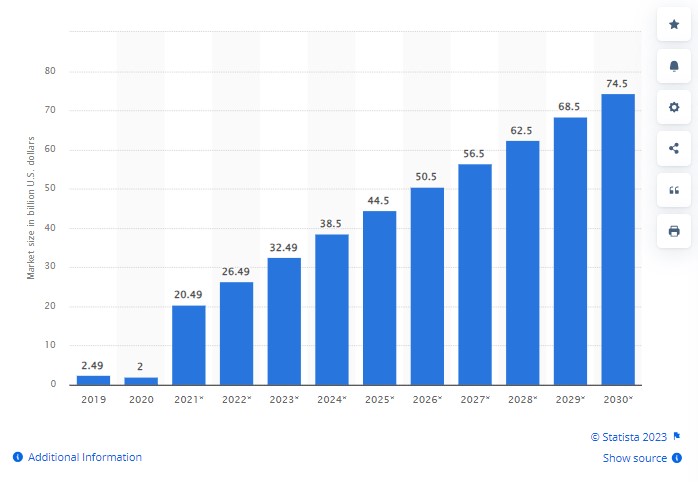
As for the prediction on AI in automotive adoption, the Automotive AI market is expected to witness a significant estimated Compound Annual Growth Rate (CAGR) of 23.3% from 2022 to 2030, as indicated by Precedence Research. Furthermore, eMarketer predicts that by 2025, approximately 70% of licensed drivers in the United States will be operating connected vehicles.
13 Benefits Of AI In The Automotive Industry
Artificial Intelligence (AI) has become a driving force in the automotive realm, reshaping everything from vehicle creation to driver experiences. In 2023, the real-world applications of AI in the automotive sector are more pronounced than ever, highlighting its transformative potential.
1. Keeping An Eye On Drivers
AI extends its vigilance beyond the road to the people behind the wheel. Advanced systems like ‘Guardian’ by Seeing Machines use AI to detect signs of driver distraction and fatigue. They react in real-time, making small adjustments like tweaking the seat, mirrors, or temperature to keep drivers alert and secure.
2. A Helping Hand For Drivers
AI isn’t just a passive observer; it actively assists drivers. Features like lane departure warnings and real-time hazard recognition, as seen in CarVi, rely on AI to analyze driving patterns and provide timely alerts for safer journeys.
3. Battling Insurance Fraud
In 2023, AI teams up with natural language processing to uncover irregularities in insurance claims data, spotting potential fraud. This showcases AI’s growing role in safeguarding the industry against deceptive practices.
4. Preventing Accidents
Tesla’s Collision Avoidance Assist is a prime example of AI’s role in accident prevention, offering timely collision alerts, emergency braking, and intelligent acceleration in response to obstacles. AI’s ability to swiftly process data in real-time serves as a guardian angel on the road.
5. Elevating User Experiences
AI-powered solutions elevate user interactions by processing vast amounts of vehicle data. This not only delivers valuable insights but also strengthens privacy and data security standards. It marks the era of tailored recommendations and smoother interactions with vehicles.
6. Streamlining Supply Chains
Automotive giants turn to AI to optimize manufacturing and bolster supply chain efficiency. From digital workers to warehouse robots, AI technologies seamlessly automate repetitive tasks, ensuring the wheels of production keep turning smoothly.
7. Predictive Maintenance
AI can anticipate when a vehicle needs servicing by analyzing data from sensors and performance measurements. This proactive approach helps avoid unexpected breakdowns and ensures that vehicles remain in peak operating condition. For example, AI can predict when an oil change or brake pad replacement is necessary based on wear and tear.
8. Enhanced Fuel Efficiency
AI systems can boost fuel efficiency by examining driving habits, traffic conditions, and vehicle information. This leads to smarter fuel consumption, resulting in cost savings for both individual drivers and businesses with vehicle fleets. For instance, AI can recommend optimal speeds and gear shifts to maximize fuel economy.
9. Personalized In-Car Assistance
Beyond entertainment, AI can deliver tailored assistance to drivers and passengers. It can adjust settings, offer restaurant suggestions, answer questions, and enhance the overall driving experience. For instance, AI can learn a driver’s preferences for seat position, climate control, and music, automatically adjusting these settings when the driver enters the vehicle.
10. Fleet Management Optimization
AI tools empower efficient management of vehicle fleets, including monitoring driver behavior, scheduling maintenance, and optimizing routes for delivery services. This leads to cost savings and improved operational efficiency. For example, AI can track driver performance, ensuring safe and fuel-efficient driving practices.
11. Reduced Traffic Violations
AI-based systems can monitor driver behavior and issue warnings for speeding, running red lights, or other traffic violations. This contributes to safer roads by encouraging responsible driving habits. For instance, AI can provide visual and auditory alerts when a driver exceeds the speed limit.
12. Enhanced Data Security
As vehicles become more connected, AI plays a critical role in safeguarding sensitive data from cyber threats. This ensures the security and privacy of vehicle occupants. For example, AI can detect and block unauthorized access attempts to in-car systems and data.
13. Environmental Impact Reduction
AI-driven eco-driving systems can encourage environmentally conscious driving practices, lowering carbon emissions and supporting sustainability efforts. For instance, AI can offer guidance on gentle acceleration and braking to reduce fuel consumption and greenhouse gas emissions.
25 Use Cases With Real-world Examples Of AI In The Automotive Industry
1. Autonomous Driving
One of the most prominent applications of AI in the automotive sector is autonomous driving. AI-powered self-driving cars leverage technologies like machine learning, computer vision, and sensor fusion to navigate, detect obstacles, and make real-time decisions on the road. Companies like Tesla, Waymo, and GM’s Cruise are at the forefront of developing autonomous vehicles.
Real World Example
Companies like Tesla and Waymo are leading in this area. Chinese technology start-up Haomo.AI also launched DriveGPT, an autonomous driving support platform.
2. Predictive Maintenance
AI helps automakers predict when a vehicle needs maintenance by analyzing data from sensors and historical performance. This proactive approach ensures timely repairs, minimizes breakdowns, and extends vehicle lifespan. Manufacturers can save costs and improve customer satisfaction through predictive maintenance.
Real World Example
BMW uses AI-powered solutions for predictive maintenance. Hyundai and Kia Motors’ Engine NVH Research Lab has developed a solution that allows AI learning of automotive sounds to detect faulty components. Toyota has explored AI applications for its business and industry, including predictive-demand taxi dispatch service and autonomous driving.
3. Driver Assistance Systems
AI-driven driver assistance systems enhance safety by monitoring the driver’s behavior and surroundings. These systems provide features like adaptive cruise control, lane-keeping assistance, and collision avoidance. They assist in mitigating accidents and reducing human errors.
Real World Example
Companies like Motional and Waymo are using AI in cars for driver assistance.
4. Traffic Management And Navigation
AI optimizes traffic flow by analyzing real-time data on road conditions, accidents, and congestion. Advanced navigation systems use AI to suggest optimal routes, helping drivers avoid traffic jams and reach their destinations faster.
5. Enhanced In-Car Experience
AI personalizes the in-car experience by analyzing driver preferences. It adjusts climate control, music playlists, and infotainment options based on individual preferences. Voice assistants like Amazon’s Alexa and Google Assistant further enhance interaction within the vehicle.
Real World Example
Porsche is offering new AI capabilities through its machine learning-powered configuration system, the “Recommendation Engine,” which suggests vehicle packages based on drivers’ individual preferences.
6. Supply Chain Optimization
Automotive manufacturers employ AI for supply chain management. AI systems predict demand, optimize inventory levels, and streamline logistics. This reduces costs and ensures timely delivery of parts, enhancing overall efficiency.
Real World Example
Modern vehicle manufacturers extensively rely on AI to streamline supply chain management. BMW uses AI-powered solutions for tasks like predictive maintenance of welding tongs, and it has been using AI and quantum computing to optimize its supply chain.
7. Quality Control
AI systems with computer vision inspect vehicles during production to identify defects. They can detect even minor imperfections, ensuring the highest quality standards are met. This reduces rework and improves product quality.
Real World Example
BMW uses AI-powered solutions for tasks like paintwork quality analysis.
8. Connected Vehicles
The IoT (Internet of Things) and AI enable vehicles to communicate with each other. Connected cars can exchange data on traffic conditions, road hazards, and more. This connectivity enhances safety and efficiency on the road.
Real World Example
Ford is using AI to develop its Vehicle-to-Everything (V2X) communication technology. Tesla is using AI to develop its autopilot and self-driving features. BMW is using AI to develop its Personal Co-Pilot driver assistance system.
9. Customer Service Chatbots
AI-powered chatbots assist customers with inquiries, scheduling test drives, providing information on vehicle features, and gathering feedback. They enhance customer interactions, streamline processes, and improve brand loyalty.
Real World Example
Mercedes-Benz has demonstrated a ChatGPT-enabled voice assistant.
10. Emission Monitoring
In response to global environmental concerns, AI aids automakers in measuring and reducing their carbon footprint. AI-based systems monitor greenhouse gas emissions, helping manufacturers meet sustainability goals.
AI could reduce greenhouse gas emissions by 5% to 10% globally by 2030 through tools to optimize carbon-free energy production operations, such as wind farms, optimize traffic with autonomous vehicles, and predict when equipment will need repair to reduce carbon-emitting failures.
Real World Example
Volkswagen is using AI to develop a new generation of electric vehicles with longer ranges and lower emissions. Toyota is using AI to develop new fuel-cell vehicles with zero emissions. General Motors is using AI to develop new electric and fuel-cell vehicles with zero emissions.
11. Fleet Management
Fleet managers utilize AI to optimize routes, predict maintenance needs, and monitor driver behavior. This leads to improved efficiency, cost savings, and safer operations.
Real World Example
Companies like Amazon, Tusimple, and Nuro are investing in transport automation technologies, such as autonomous trucks, for efficient logistics in a supply chain.
12. Demand Forecasting
AI helps automotive companies forecast demand accurately by considering economic conditions and industry changes. This enables efficient production planning and minimizes excess inventory.
Real World Example
AI has proved effective for demand forecasting in the automotive industry. For instance, a European original equipment manufacturer has used machine learning algorithms to forecast demand in a real-world use case scenario.
13. Driver Behavior Analytics
IoT sensors collect data on driver behavior, including factors like brake usage, fuel consumption, and vehicle downtime. AI analyzes this data to improve vehicle design and driver safety.
Real World Example
Companies like Tesla and Waymo are using AI to analyze driver behavior and improve vehicle design and driver safety. General Motors has developed a vehicle intelligence platform for its next-generation vehicles, which includes active safety and driver assistance systems.
14. Enhanced Battery Engineering
AI assists in designing more efficient batteries for electric vehicles by predicting performance under various conditions. This accelerates battery development and reduces product development cycles.
AI is helping engineers to develop the next generation of electric and low-emission vehicles. Machine learning models can rapidly predict how batteries will respond under different conditions, accelerating battery development.
15. Marketing Automation
AI is being integrated into the automotive sector to personalize advertisements, forecast demand, and enhance marketing strategies. AI-powered marketing tools analyze customer data, enabling automakers to personalize advertisements, forecast demand, and enhance marketing strategies. This boosts customer engagement and sales.
Real World Example
Ford has been using AI in various ways, including personalizing marketing campaigns.
16. Combatting Insurance Fraud
AI, along with natural language processing, identifies suspicious patterns in insurance claims, helping insurers detect and prevent fraud. This reduces fraudulent payouts and lowers premiums.
Real World Example
Companies like Fermion are using AI and data science to expedite the delivery of insights throughout the claims process, enhancing the accuracy of assessment, improving cost management, and aiding in the detection and prevention of fraudulent activities.
17. Equipment Predictive Maintenance
IoT sensors combined with AI predict equipment failures in manufacturing, reducing maintenance costs and downtime. It ensures machinery operates efficiently.
Real World Example
Companies like BMW, Siemens, and GE are using AI-powered solutions for predictive maintenance of various equipment.
18. Intelligent Driver Care
AI systems monitor driver behavior in real-time, detecting signs of drowsiness or distraction. They can intervene by alerting the driver or initiating self-driving mode, enhancing road safety.
Real World Example
Tesla’s vehicles work on advanced driver assistance systems (ADAS) and autonomous driving capabilities by utilizing AI algorithms for decision-making and driving control. In fact, Mercedes-Benz offers an AI-powered driver attention assist system, and Volvo offers an AI-powered driver monitoring system.
19. Autonomous Valet Parking
AI-driven autonomous valet parking systems enable vehicles to independently navigate and park in designated areas within parking facilities. These systems utilize advanced sensors, cameras, and mapping technology to ensure precise positioning. Drivers can simply drop off their vehicles at a designated drop-off point, and AI takes care of the parking process. This not only saves time but also optimizes parking space utilization, making parking more efficient and convenient for users. The vehicle can later be summoned by the driver using a mobile app, enhancing the overall parking experience.
Real World Example
Companies like Mercedes-Benz and BMW have integrated Nvidia Orin systems for comprehensive Autonomous Valet Parking (AVP). Even BMW and Audi are all set to offer an autonomous valet parking system.
20. Driver Monitoring For Safety
AI-based driver monitoring systems utilize a combination of cameras and sensors to continuously assess the driver’s state while behind the wheel. These systems analyze factors such as head position, eye movement, steering behavior, and facial expressions to detect signs of fatigue, distraction, or impairment. If the system identifies a potential safety risk, it can issue warnings, such as audible alerts or seat vibrations, to prompt the driver’s attention. In more advanced implementations, AI can even take control of certain driving tasks or assist in emergency situations, contributing significantly to road safety.
Real World Example
AI-based driver monitoring systems are being used by companies like Tesla to continuously assess the driver’s state while behind the wheel. They have started using the in-car camera in their Model 3 and Model Y vehicles to monitor drivers when its Autopilot advanced driver assistance system is being used. Additionally, General Motors has created a brand-new platform for vehicle intelligence. This platform is essential for their upcoming generation of vehicles, including electric vehicles (EVs), as well as for incorporating advanced connectivity features and enhancing the Super Cruise driver assistance system.
21. Vehicle-To-Everything (V2x) Communication
AI plays a crucial role in enabling V2X communication, allowing vehicles to exchange real-time data with other vehicles and infrastructure elements such as traffic signals and road signs. AI algorithms process this data to enhance road safety and traffic management. For instance, V2X communication can provide warnings about nearby accidents, road closures, or adverse weather conditions, allowing drivers to take proactive measures. Additionally, it can optimize traffic flow by coordinating vehicle movements and reducing congestion, leading to smoother and safer journeys for all road users.
Real World Example
Autotalks, a small apparatus that connects to the handlebar of your bicycle to avoid the risk of collision, is an example of V2X connectivity in action. Last year, Ford announced that it would begin deploying V2X communications in all its new cars, and Toyota is planning to use dedicated short-range communication (DSRC) technology based on WiFi for V2X communication.
22. Virtual Reality (VR) Test Drives
AI-powered VR simulations provide potential car buyers with immersive virtual test drive experiences. These simulations are highly detailed and realistic, allowing customers to explore different vehicle models and features from the comfort of their homes or dealerships. Users can interact with the virtual vehicle, test various driving scenarios, and experience the car’s performance firsthand. AI algorithms enhance these simulations by adapting to user preferences and providing personalized recommendations based on the user’s feedback and requirements. This innovative approach revolutionizes the car-buying process, enabling customers to make informed decisions before purchasing a vehicle.
Real World Example
Companies like BMW and Volvo have been using VR for test drives. Volvo has been using Varjo’s XR-1 hardware, which allows drivers to experience the inside of a car that only exists in pixels. BMW Group also demonstrated the use of the panoramic windshield as an augmented reality (AR) display at CES 2020.
23. Road Condition Monitoring
AI-driven road condition monitoring systems utilize data from various sensors, including those on vehicles and infrastructure, to continuously assess the condition of roads. AI algorithms analyze this data to detect potential hazards such as icy patches, potholes, or debris on the road. When a hazard is identified, the system can provide real-time warnings to drivers, enhancing safety. Additionally, road authorities can use this data to plan maintenance and prioritize road repairs, improving overall road quality and reducing accidents caused by poor road conditions.
Real World Example
Tesla uses AI to monitor road conditions in real-time, and BMW uses AI and connected car technology to improve safety and efficiency.
24. Energy Efficiency Optimization
AI is instrumental in optimizing the energy usage of electric vehicles (EVs). AI algorithms continuously monitor and analyze various parameters, including battery state, driving conditions, and climate control settings. Based on this data, AI can optimize the operation of the vehicle’s electric drivetrain, regenerative braking, and heating/cooling systems to maximize energy efficiency. This results in extended battery life, increased driving range, and reduced energy consumption, making EVs more practical and environmentally friendly.
Real World Example
Tesla has been one of the leaders in automotive AI adoption since 2003. It is known for its electric vehicles and has been working on improving the efficiency of its batteries. Hyundai has been reported to use AI to improve the efficiency and cost-effectiveness of its electric vehicle (EV) batteries.
25. Personalized Vehicle Recommendations
AI-driven personalized vehicle recommendation systems leverage user data, such as driving habits, preferences, and budget, to provide tailored recommendations for vehicle models and features. These systems use machine learning to analyze vast amounts of data and generate customized suggestions. For example, if a user values fuel efficiency and frequently drives in urban areas, the AI system may recommend hybrid or compact cars with excellent city mileage. This level of personalization enhances the car-buying experience, helping customers find the most suitable vehicle that aligns with their specific needs and preferences.
Real World Example
Porsche released a machine-learning configuration system called ‘Recommendation Engine’ that uses AI to determine unique and suitable options for the driver.
Top 12 Automotive Companies Utilizing AI In 2023
In 2023, several automotive companies are utilizing AI in various ways:
1. Tesla
Tesla is known for its electric vehicles and has been working on improving the efficiency of its batteries. It uses AI to monitor road conditions in real time. The company’s AI system gathers visual data from eight cameras in the car, producing a 3D output that identifies the presence of obstacles, their motion, roads, and traffic lights
2. Ford
Ford has established Latitude AI, a subsidiary focused on developing a hands-free, automated driving system for millions of vehicles. They are also working with Qualcomm on testing and development of Vehicle-to-Everything (V2X) communication technology.
3. BMW
BMW uses AI for various purposes, including predictive maintenance and quality control. They use AI-powered solutions for predictive maintenance of welding tongs and paintwork quality analysis. They also use AI in their Personal Co-Pilot driver assistance system and in the management and analysis of their production intelligently.
4. Toyota
Toyota is using AI to develop new fuel-cell vehicles with zero emissions. They have unveiled a prototype hydrogen fuel-cell electric Hilux, which uses core elements from the Toyota Mirai hydrogen fuel-cell electric sedan.
5. Audi
Audi harnesses artificial intelligence (AI) across its automotive operations, including pioneering AI for production quality monitoring by assessing welds and identifying part defects, enhancing supply chain efficiency through proactive monitoring, optimizing planning using analytics, and employing AI to detect flaws in metal sheets, ensuring high production standards.
6. Mercedes-Benz
Mercedes-Benz is proactively adopting AI technology to improve the customer experience. Mercedes-Benz is using technologies like generative AI and Nvidia’s Omniverse to make cars smarter, cars that can talk to you and communicate more precisely what they need. They also use virtual and augmented reality (VR/AR) technologies for engineering, marketing, driver, and customer experiences, as well as employee training.
7. Volkswagen
Volkswagen is using AI to develop a new generation of electric vehicles with longer ranges and lower emissions. They plan to launch almost 70 new electric models in the next ten years.
8. Hyundai
Hyundai is using AI in various ways. For instance, Motional, a joint venture between Aptiv and Hyundai Motor Group, is using AI to develop autonomous driving technology. They have also been reported to use AI to improve the efficiency and cost-effectiveness of their electric vehicle (EV) batteries.
9. Nissan
Nissan is utilizing AI to enhance its customers’ satisfaction. They have devised an inspection scanner that can evaluate the condition of car parts with a 99.995 percent accuracy. They are also planning to produce only electric vehicles in Europe by 2030
10. General Motors
GM is exploring the feasibility of introducing ChatGPT, an AI chatbot, into its vehicles. They have also teamed up with Google Cloud to bring conversational AI technology into millions of GM vehicles. Leveraging artificial intelligence and cloud computing, General Motors (GM) is exploring a spectrum of design possibilities for various vehicle parts and components using generative design techniques.
11. Waymo
Waymo, a subsidiary of Alphabet Inc., uses generative models to generate thousands of distinct scenarios, mirroring a wide array of real-world conditions, to train their self-driving algorithms. By employing AI to create these scenarios, Waymo can expose its autonomous systems to diverse driving situations, resulting in enhanced safety and improved resilience.
12. Nvidia
Nvidia is enabling automakers to transform their entire workflow using the NVIDIA Omniverse platform and AI. They showcase how digitalization can deliver greater efficiency, safety, and customer enjoyment. Nvidia’s AI and Omniverse platforms are being used by automakers to digitize every phase of the product lifecycle — including concept and styling, design and engineering, software and electronics, smart factories, autonomous driving, and retail. They also help automakers bypass traditional bottlenecks to save critical time and reduce costs.
Future Of AI In The Automotive Industry
The future of AI in the automotive industry is set for a remarkable transformation. Autonomous vehicles predicted to capture 10-15% of the market share by 2030, are at the forefront, with Tesla and Google leading the charge. AI is also set to revolutionize automotive manufacturing, optimizing everything from design to project management. The integration of IoT devices further enhances this process, creating a data-rich environment that boosts efficiency.
Safety is a paramount concern in this sector, and AI is instrumental in enhancing it. For instance, Tesla uses AI-powered cameras to monitor driver attentiveness, preventing accidents caused by drowsiness. Furthermore, AI plays a crucial role in improving the energy efficiency of electric vehicles (EVs). Advanced AI algorithms continually monitor and analyze various parameters like battery status and driving conditions, leading to improved energy efficiency and extended battery life.
But the influence of AI isn’t confined to technical aspects; it’s also reshaping the customer experience. AI-driven features offer personalized interactions and interfaces for car owners, ensuring a seamless and immersive experience. Overall, we can say that the future of the automotive industry lies in harnessing the power of AI.
Conclusion
Integrating AI in the automotive industry has revolutionized the sector, offering many benefits — from designing new prototypes to predictive maintenance. AI has become indispensable in enhancing driver safety, improving passenger experience, and increasing supply chain efficiency. It’s clear that the future of the automotive industry lies in harnessing the power of AI.
However, to truly leverage these benefits, it’s crucial to partner with a company with proven AI expertise. That’s where Idea Usher comes in. With a team of expert AI developers, we are your go-to partner for integrating AI into your automotive business. Whether your project requirements involve autonomous driving, predictive maintenance, or personalized vehicle recommendations, we can deliver AI solutions that align perfectly with your business goals. Our expertise spans various sectors, making us an ideal partner for any business looking to harness the power of AI. So why wait? Start with your AI journey with Idea Usher and contact us today! and embark on your journey towards a smarter, more efficient business powered by AI.
Work with Ex-MAANG developers to build next-gen apps schedule your consultation now
Contact Idea Usher at [email protected]
FAQ
Q. What is AI in the automotive industry?
AI encompasses machines’ capacity to perform a range of functions, including learning, logical thinking, creative ideation, design, and decision-making, typically reliant on human involvement. Within the automotive sector, AI is leveraged to enhance vehicle efficiency, driver security, passenger satisfaction, and more by meticulously scrutinizing data and executing real-time decisions derived from this information.
Q. How is AI impacting the automotive industry?
AI is significantly impacting the automotive industry by revolutionizing vehicle safety, performance, and efficiency. It drives advancements in autonomous driving, electric vehicles, and in-car personalization. AI systems enhance road safety, streamline manufacturing, reduce costs, and optimize supply chain management. This transformative influence results in safer, smarter, and more sustainable vehicles while increasing manufacturing efficiency and sustainability across the industry.
Q. How is AI improving safety in the automotive industry?
AI plays a vital role in bolstering safety within the automotive industry. Corporations like Tesla utilize AI-driven interior cameras to observe drivers’ alertness, mitigating the risk of on-road accidents. This technology builds upon the firm’s neural network technology, which assesses road imagery for tasks such as object detection and depth estimation.
Q. What is the future of AI in vehicles?
The future of AI in vehicles is poised for significant growth and transformation. AI will continue to advance vehicle safety, enabling autonomous driving features, enhancing user experiences, and optimizing transportation efficiency. As AI technology evolves, it will bring about revolutionary changes in the automotive industry, leading to safer and more intelligent vehicles. This future holds the promise of reducing accidents, improving traffic management, and ushering in a new era of sustainable and efficient transportation solutions.
